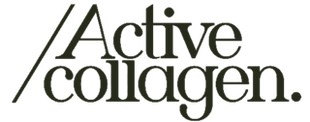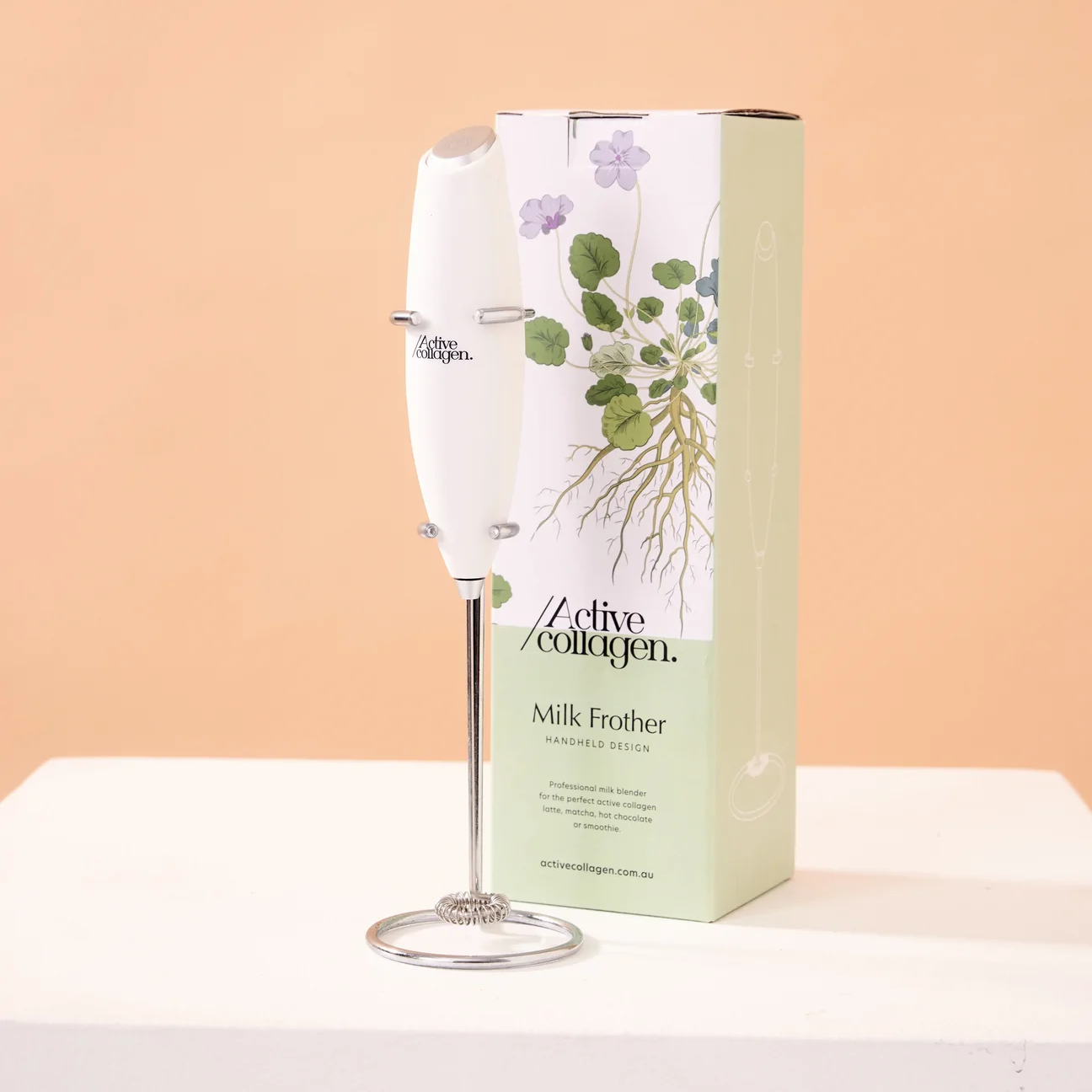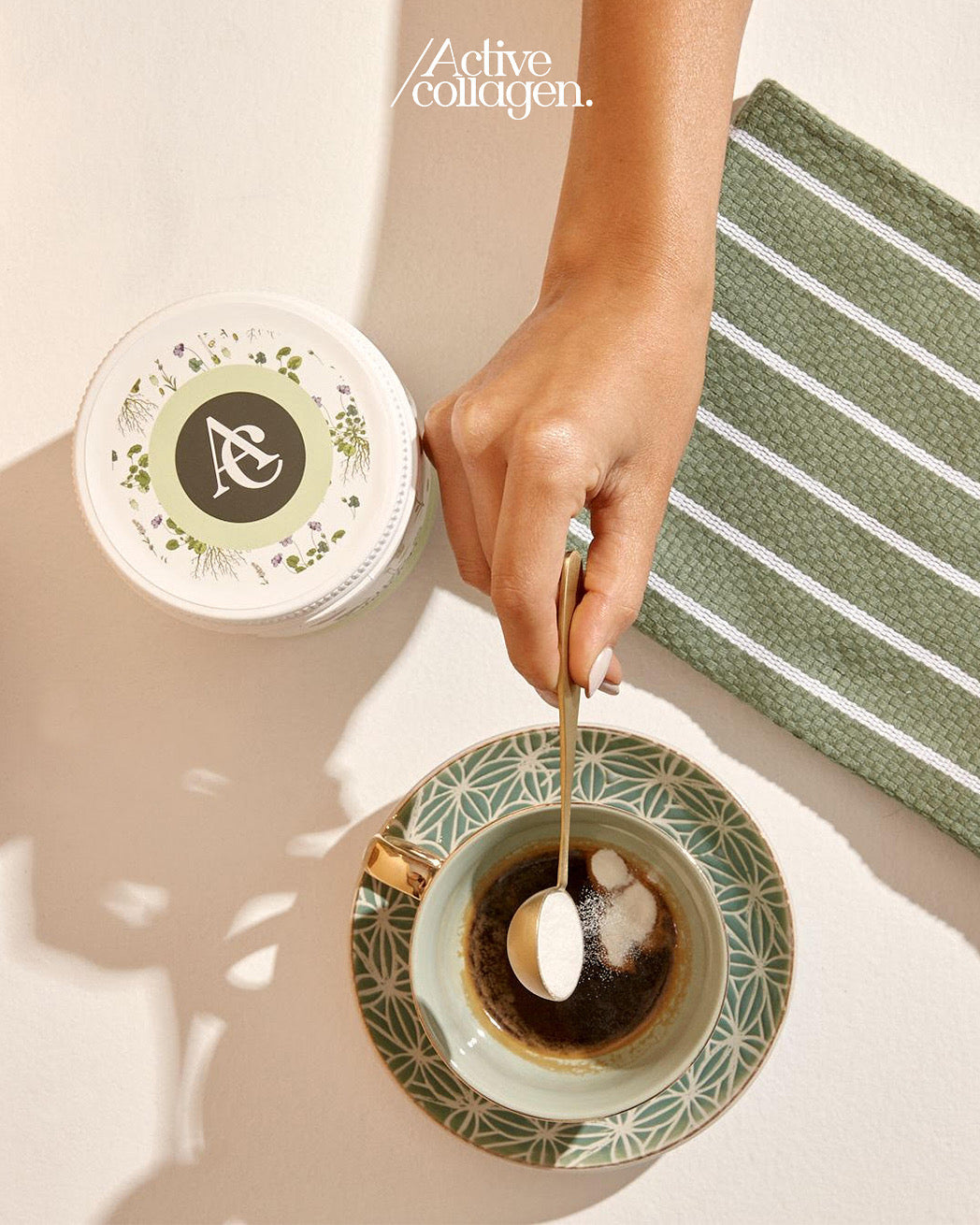To kick things off, first let’s make something clear. Collagen is the key to supporting the process of aging. As we get older – from around our early twenties – the body starts to lose collagen, an integral and abundant protein that is often referred to as the glue that holds everything together. This is seen as a decrease of 1% in the body’s collagen per year. This amount might not seem like much, but boy does it have an impact.
Although, there is this natural ongoing loss of collagen, you’ll be pleased to know there are ways we can support our collagen levels to preserve the skin you’re in!
Are you noticing the visible & physical signs of aging? Increased wrinkles, reduced skin elasticity, dehydration, decreased firmness, and sore joints? Let us give you the 411 on collagen to learn what it is, why we lose it and why you should be taking it daily.
What am I?
Again, collagen is one of the most abundant proteins in the human body comprising one third of the body’s total protein. It lays the foundations for several bodily components such as our hair, nails, skin, bones, and connective tissues (cartilage, tendons, ligaments).
What collagen proteins bring to the table is their ability to give these bodily tissues strength and structure. These qualities are provided by collagen’s structural formation. Apart from being referred to as glue, think of collagen as rope. Its formation consists of 3 proteins or amino acids (the smaller building blocks that make-up one larger protein) all linked in a chain, coiling around each other to form a helical structure resembling that of a rope.
Though collagen is integral for the formerly mentioned tissues, you will find the majority of our body’s collagen in the skin – three quarters of the skin’s total protein. So, it’s no wonder that when collagen levels are on the decline our skin is negatively affected.
Are There Different Types of Collagen?
There are a whopping 28 different types of collagen proteins that have been discovered in vertebrate’s, aka humans. Though, there are only a few in humans that are important to focus on as we age – type I & type III collagen.
Type I collagen: the most plentiful of them all! Type I collagen is prevalent and present in the dermis, bones, ligaments, and tendons. It is characterised into the group of collagens known as fibrillar collagens due to its rope-like structure. Type I collagen is important for the strength of our tissues.
Type III collagen: also characterised as a fibrillar collagen, Type III is present within the skin, blood vessel walls, and bowel. It gives these tissues their structural integrity i.e., elasticity.
Why Focus on Supporting Collagen?
Without sufficient collagen production we are exposed to the visible signs of aging – wrinkles, skin dehydration, loss of elasticity and reduced fullness. This is due to collagens ability to provide structural support and retain hydration within the skin’s matrix. These of course are more appearance-based reasons that appeal when it comes to prioritising collagen.
However, another factor when it comes to skin health - which becomes apparent with aging and a reduction in collagen – is collagens major role in wound healing. At the site of a wound, collagen is responsible for forming a clot and remodelling the skin and is deposited by cells known as fibroblasts. When collagen declines in abundance, this leads to poor wound healing involving an increase in healing time.
On top of that, collagen is also necessary for healthy bones. Like collagen, our bone mineral density decreases as we age. I know right, give us a break! Collagen provides bones with the ability to retain calcium and regulate bone remodelling functions. So, by supporting our body’s collagen levels, we can help maintain the bones we’ve built.
What Factors Influence Collagen Loss?
Obviously aging plays a big part in the loss of our collagen. Though there are certain other modifiable factors that influence declining collagen levels.
UV exposure: our skin is the most impacted when it comes to UV radiation. And with this comes a decrease in collagen. Sunshine has shown to impact collagen via deforming the collagen structure, thereby decreasing skin elasticity.
Stress: chronic psychological stress involving a sustained increase in the hormone cortisol can lead to negative effects on collagen through impairing the function of fibroblasts which are responsible for collagen deposition. On the other hand, physical stress such as repetitive movements can influence the joint cartilage, degrading collagen proteins within the joint capsule.
Smoking & alcohol: these factors increase oxidative stress within the body, which leads to the production of free radicals – molecules that cause damage to our cells. Smoking damages the repair mechanisms within skin that are normally responsible for collagen production. Whereas alcohol impacts the skin antioxidant system, necessary for defending the skin against free radicals.
Why Active Collagen?
Active Collagen is a specially formulated hydrolysed collagen powder – meaning it is a form which is most bioavailable for your body to use. How does our collagen stand out from the rest? Our All-In-One Hair Skin & Nails contains VERISOLô Type I & III collagen peptides, targeted to support the tissues most affected by collagen loss. Plus, it is fortified with extra structure supporting nutrients – Vitamin C, Biotin and Silica – so you know you’re getting the most out of the product. Try it for yourself and start feeling the benefits of Active Collagen.
Lim, H. S., Lee, S. H., Seo, H., Lee, H. H., Yoon, K., Kim, Y. U., Park, M. K., Chung, J. H., Lee, Y. S., Lee, D. H., & Park, G. (2022). Early stage ultraviolet irradiation damage to skin collagen can be suppressed by HPA axis control via controlled CYP11B. Biomedicine & pharmacotherapy = Biomedecine & pharmacotherapie, 155, 113716. https://doi.org/10.1016/j.biopha.2022.113716
Shoulders, M. D., & Raines, R. T. (2009). Collagen structure and stability. Annual review of biochemistry, 78, 929–958. https://doi.org/10.1146/annurev.biochem.77.032207.120833
Naomi, R., Ridzuan, P. M., & Bahari, H. (2021). Current Insights into Collagen Type I. Polymers, 13(16), 2642. https://doi.org/10.3390/polym13162642
Kuivaniemi, H., & Tromp, G. (2019). Type III collagen (COL3A1): Gene and protein structure, tissue distribution, and associated diseases. Gene, 707, 151–171. https://doi.org/10.1016/j.gene.2019.05.003
Mathew-Steiner, S. S., Roy, S., & Sen, C. K. (2021). Collagen in Wound Healing. Bioengineering (Basel, Switzerland), 8(5), 63. https://doi.org/10.3390/bioengineering8050063
Zdzieblik, D., Oesser, S., & König, D. (2021). Specific Bioactive Collagen Peptides in Osteopenia and Osteoporosis: Long-Term Observation in Postmenopausal Women. Journal of bone metabolism, 28(3), 207–213. https://doi.org/10.11005/jbm.2021.28.3.207
Kahan, V., Andersen, M. L., Tomimori, J., & Tufik, S. (2009). Stress, immunity and skin collagen integrity: evidence from animal models and clinical conditions. Brain, behavior, and immunity, 23(8), 1089–1095. https://doi.org/10.1016/j.bbi.2009.06.002
Goodman, G. D., Kaufman, J., Day, D., Weiss, R., Kawata, A. K., Garcia, J. K., Santangelo, S., & Gallagher, C. J. (2019). Impact of Smoking and Alcohol Use on Facial Aging in Women: Results of a Large Multinational, Multiracial, Cross-sectional Survey. The Journal of clinical and aesthetic dermatology, 12(8), 28–39.





Comments
Amazing product, I feel renewed and not bloated. My skin, hair and nails are the healthiest they have been in years. I thought this was just aging dull hair and skin, but I feel beautiful from the inside which shows on the outside, Thank you for an amazing product. xx